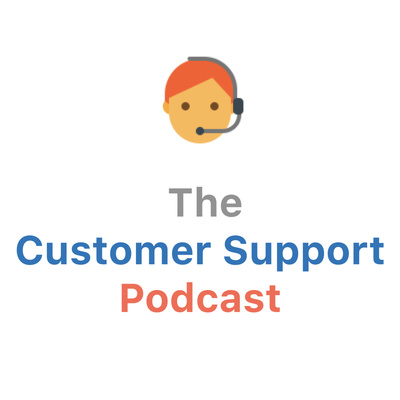
The Customer Support Podcast
By Sandeep Jain
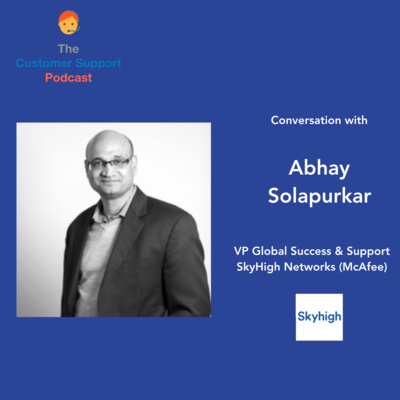
The Customer Support PodcastMar 14, 2020

Episode 24: (B2B) Abhay Solapurkar, VP Global Success & Support, SkyHigh Networks (McAfee)
- SkyHigh Networks (Acquired by McAfee) is a CASB vendor serving roughly 600 customers (Fortune 1000 and enterprises)
- Tierless support organization
- Roughly 70 engineers worldwide organized in pods of technology excellence. Overall McAfee has 800+ Tech Support professionals
- Support team sits with engineering and cloud ops
- Customer Success Managers do consultative work (not comped on renewal)
- Big shift in Support has come due to “Cloudification”
- Important to focus on overall customer experience rather than on an individual metric like first response time etc.
- Robust certification process for new employees
- Technology stack - Consolidated with Salesforce, Financial force (professional services), tight integration with JIRA, Inquira (Knowledge Management), Exploring Chatbots (Aisera - doing pilot on consumer side for how-to cases).
- Support app for customers
- Incoming cases - 98% (email and web), 2% (phone)
- How-to/Break-Fix Split - For on-prem (30/70), cloud (10/90)
- Recommended Read - Good to Great by Jim Collins

Episode 23: (B2B) Joshua Lory, Sr. Dir. Product Marketing, Global Services, VMware
- Josh is Sr Director Product Marketing, Global Services, VMware
- VMware has ~500K customers & partners around the globe.
- Support is seen as competitive differentiator and growth engine for VMware and that's how they decided to run Support like product team
- Org structure -- Roughly 2500 folks reporting into Chief Customer Officer (Scott). 3 teams — Support (Global Support Services), Digital Services (Product + Engg + Marketing), Customer Advocacy.
- Technology Stack -- Salesforce (Ticketing, Knowledge Base), IBM Watson for Machine Learning/AI, Coveo for Search
- Two internally built products -- Skyline and SupportHub
- Skyline -- uses telemetry information coming out of VMware products to alert customers /partners about known issues in KB, security vulnerabilities, configuration best practices etc.
- Roughly 7500 customers on the service, adding roughly 1000 customers every month. Average # of tickets being filed are going down
- Skyline is included in support subscription and not priced separately
- SupportHub — Integrated with ticketing system. Simplifies filing experience and reduces customer effort.
- AI-powered support experience e.g., routing to best engineer.
- Announced at VM World 2019 in partnership with IBM Watson.
- Beta with top customers.
- Releasing to more customers throughout 2020.
- Vast majority of tickets come from web (myvmware) / Twitter support as well (integrated with Salesforce)
- Metrics: NPS (51 for Vmware, Average is around 21), CSAT, Customer Effort
- Recommend listen - Delta CEO Ed Bestian keynote at CES on how they used fit bits to understand customer journey
- Resources — The Obstacle is the Way by Ryan Holiday, How to Think Like a Roman Emperor, Meditations by Marcus Aurelius, Crucial Conversations
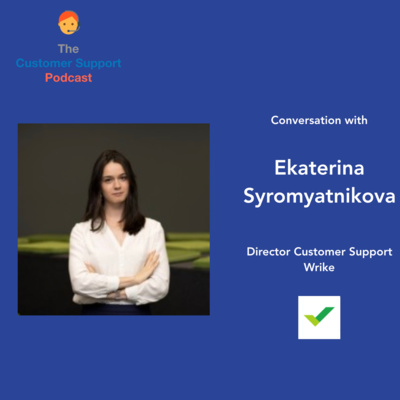
Episode 22: (B2B) Ekaterina Syromyatnikova, Director Support, Wrike
- Wrike provides a SaaS platform work management — project management and collaboration
- Customers are small business to enterprise level. 20K+ across 130 countries. Freemium model
- 60+ people in support team across Eastern Europe. Two tiered support. Majority in Tier-1. Support Ops and Documentation team part of overall support team as well
- Several thousand tickets per month across email, web, live chat (paid customers only) and phone
- Incoming cases — 10-15% product issues. Rest how-to cases
- Support tool stack: Zendesk, Guru (internal knowledge), Wrike (task management)
- Friction points in Support: Integration of different customer facing systems e.g., last conversation with CSM, sales conversations etc.,
- Priority for coming year - Premium support for enterprise customers / Self-service to all (agent chat is available to certain customers only today
- Metrics — First Response Time (FRT), Time to Resolution, Quality of response (Customer Effort Score). Used to measure CSAT earlier — response rate was good but lacked in meaningful insights
- Things to note — Support is not outsourced, opportunities for horizontal growth for support engineers
- Books — Effortless Experience (Matthew Dickson, Nick Toman), Radical Candor (Kim Scott), Why its so hard to be fair (HBR).
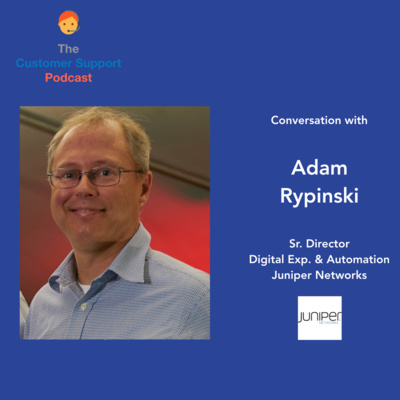
Episode 21: (B2B) Adam Rypinski, Sr. Dir. Digital Experience & Automation, Juniper Networks
"Single pane of glass for simplistic support is missing"
- Adam’s team is responsible for support operations
- Customers — Traditionally sold products to Service Providers but now sell to a lot of enterprises globally
- Support Organization— Primary JTAC (Juniper Technical Assistance Center) — outsourced Level-1 support , Advanced TAC (Level-2/3 Support), Advanced Services, Resident Engineers, Named Engineer(s), Customer Care for administrative support, Customer Success (just starting). Teams are primarily global. Roughly 1200 people. Tier-1 /outsourced is roughly ~500.
- Support Tech stack — Moving over to Salesforce ServiceCloud (ticketing, community). Search is Coveo. Believe in Buy (vs build). Mobile App is desired by missing
- Incoming tickets — 75%+ over web, no email
- Case deflection — Roughly 80% cases closed by Tier-1
- Self-service — current channels requires effort and time on part of customer. Single pane of glass for support is missing
- Chatbots — Trying out Salesforce bot for transactional support (update on case, re-send welcome email letter for subscriptions etc.)
- AI/ML — lot of technologies (including open source) out there. Planning to use chatbot for transactional queries.
- Metrics — MTTR is #1 target. Efficiency for internal Support as well
- Support has changed dramatically over years — people want answers and solutions lot faster. Support channel is now mobile
- Resources — Customer Success by Nick Mehta, Start with Why by Simon Sinek, Look at More by Andy Stefanovich

Episode 20: (B2B) Patty Hatter, SVP Global Customer Services, Palo Alto Networks
Key metric for Services organization (from a SaaS perspective) is Renewal
- Patty leads Global Services Organization — Support, Professional Services and Success
- Palo Alto is going through a huge transformation from a hardware company to more of a SaaS company. Partners going through transformation as well
- Huge focus on direct education to customers and even educating partners
- SaaS changes entire customer journey from pre-sales to post-sales — handoff is even more critical
- Clear customer journey map is needed to do this handoff properly
- Self-service and machine learning are big themes in services
- We need to take “outside-in” view of our customers
- Need to stitch together experience across all teams (support, success and professional services) in a seamless way
- Key Metrics — renewal
- Suggested resources — Everything Reid Hoffman :)
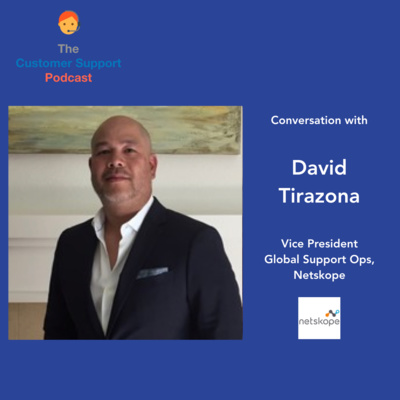
Episode 19: (B2B) David Tirazona, Vice President Global Support Operations, Netskope
“When a customer files a ticket, there is a fault in your product or training”
- Netskope customers are across different verticals — government, financial services, healthcare, retail, tech
- All support is provided directly by the company; no channel support
- Global support with 3 centers - Bangalore, Santa Clara, London
- Support team has two main components — Support and Small tools/infrastructure ops team
(roughly 60 people). Customer success is a different team. - Case volume — 1500/1600 (includes support pre-sales as well). 90%+ is over email/web. Phone is very less.
- Cases are split following way — 55% How-tos, 45% Break-fix
- Tool stack - centered around Zendesk (customer portal, knowledge)
- Priority for 2020 — contact center (five9 etc.), messaging/chat, mobile app. Essentially any tech that elevates customer experience
- Focus on simplicity, usability and supportability
- What would you do differently if you were to rewind the clock — invest more in self-service and mobile experience
- Knowledge — Support team writes articles but goes for review through technical documents. Right now knowledge is text-based, some micro-videos
- Metrics — Northstar metrics are First Response Time, Resolution Time, Break-fix issue containment (vs going to Engg), agent productivity
- Agent Productivity — measure # of issues closed per week/month along with CSAT
- Netskope has Product Experience Engineering Team — very small team that focuses on this aspect
- Zendesk categories (products/class of issues) etc. are currently selected by a drop-down menu; would be good to have that automated
- Differentiating factor in SaaS is not the product but the kind of support you provide to your customers
- Resources — Radical Candor, Good to Great, Leadership Pipeline, Can’t Hurt Me. Podcasts — a16z, masters of scale

Episode 18: (B2B) Matt Dale, Vice President Customer Support, Illuminate Education
- Illuminate offers several products for teachers, administrators, school districts and for parents
- Primary folks calling in are administrators
- Illuminate recently had a 5-way merger and had to integrate several ticketing systems — shared inbox, multiple Zendesk instances, Freshworks, Servicecloud. Done by a 3rd party — Import2.com
- Incoming tickets — several thousand a month. Volume is double during back to schools months (Aug/Sep/Oct)
- Matt leads the Support Team which is part of overall Services Team (Support, Success, Implementation, Migrations, Data Team, L&D)
- Support Team has 3 directors (focused on different products)
- Incoming ticket split over channels— Phone - 60% , Email/Web - 40% (rolling out chat as 3rd channel). Focus area -- How to reduce volume on phone (its expensive) and move it to chat or do deflection
- Support Tech — Centered around Zendesk (ticketing, chat, community ,help), Phone (Talk desk), Maestro QA (evaluate agents work). Big believers in “incremental improvement”
- Maestro QA — Connects to the ticketing system. Used to grade agents. Manually set certain criteria (people/tickets you want to grade, set certain questions) and then reviewed by human graders
- Challenge — Running reports across systems like Salesforce, Netsuite, Zendesk, JIRA is a challenge. Existing integrations are basic and don't help
- “No one wants to call support. How can we provide frictionless environment”
- Products are very customizable and many questions are unique, specific nuances that are not covered by generic help docs. We need to understand the context of customer and case so that our agents can provide prompt service
- Knowledge Management — Analyze user queries and understand what help docs are being used the most and use that as baseline for up dating knowledge. Roughly 3000 help docs across all systems
- Top priorities for 2020 — Want to build a tiered support system, revamping help docs, Live agent chat
- Learning Management System (LMS) — Both for agents and customers i.e., agent on-boarding (human intensive and not only content from general LMS, but also about Zendesk, support style etc.). Customer training — they had in-person train-the-trainer model earlier but that didn’t scale. Focus in shifting to put training in LMS and use that to train the trainer
- Key Metrics — First reply time & Total resolution time (indicates backlog especially during busy season). Common ones — CSAT etc. Prefer actionable insights e.g., automatic email being sent to agents that gives them actionable data about how they did in a certain period
- Recommendation of resources in Support — HelpScout Blog (content on Support is really good), Support Driven Community, Radical Candor, The Goal
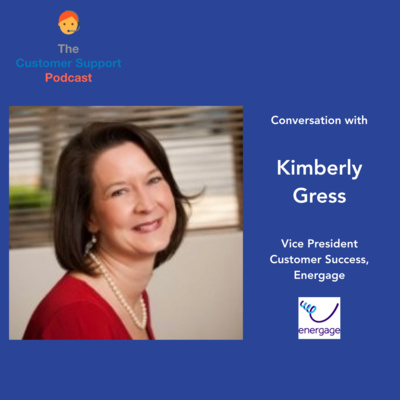
Episode 17: (B2B) Kimberly Gress, Vice President Customer Success, Energage
- Energage initially started with product that does “Top Workplace”. Companies purchase Energage to get a better sense of the data and use that to engage effectively with employees.
- Energage customers are small enterprises (50) to large enterprises (5000+ employees.). Overall 8000 customers; both paying and non-paying. Split is roughly 50/50.
- Team - Roughly 7 onboarding and support team, customer education team (just starting), product services (just starting) and customer success (5 and expanding).
- Technology — Case management (Salesforce), Contact Center (RingCentral), In-app education (Pendo).
- Case volume — Roughly 1700 cases per month. 80% over email , Chat (15% over intercom), Phone (5% over ringcentral).
- 80% case volume is Tier-1 (cases that should not have been filed). Rest are Tier-2 (cases that require agents) and Tier-3 (case that require engineering to be involved).
- Knowledge — prefer how-to articles more than video (text gives context quickly vs video). Knowledge creation needs to be part of case workflow (KCS — Knowledge Centered Support).
- 2020 Initiatives — Create a support portal, community (how to drive customers there first), knowledge management (keeping it current)
- Would like to see average time per case going up which means agents are having more meaningful conversations — Metrics (Net/Gross Retention Revenue, NPS, CSAT, Customer Health Score, etc.,
- Paid premier support is a good way to generate revenue for support teams (at Boomi, it had ~50% attach rate).
- Chatbots — curious but not part of 2020 plan.
- Resources: Podcasts - Helping Sells Radio, Revisionist History
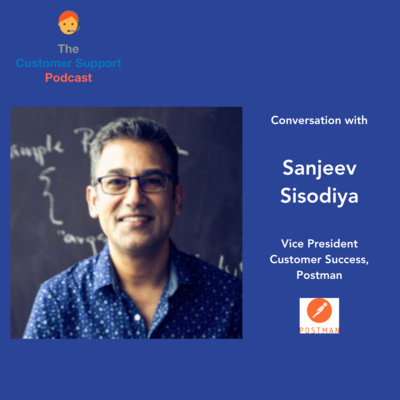
Episode 16: (B2B) Sanjeev Sisodiya, Vice President Customer Success, Postman
- Postman has 8 million registered users across 400K organizations
- Freemium model but support for all users. Changed internal perspective by not calling them “free” users but users who have not derived enough value to pay for the product.
- Sales Support in Bangalore
- Product Support needs responsiveness and is distributed across the globe.
- 10 Individuals across Hawaii, Austin, Portugal, Nigeria, New Zealand, India). That helps in managing round the clock support. Also, San Francisco and Bangalore are highly competitive markets.
- Customer success Team 6 people
- High Responsiveness — First response time in 30min - 1hr
- Annual case volume - 20K
- 90-95% incoming cases over email and even twitter.
- 10-15% break fix cases / 80% or more are How-tos.
- New agent Training — 2 weeks learning the product and then they get into actual support tickets.
- Technology stack: Zendesk (ticketing, knowledge), Slack, JIRA/Confluence (root cause analysis, documentation), Public issue tracker on GitHub (bugs and feature requests). Engineering more engaged there rather than support, User Community
- Unique thing — all conversations are logged on to ONE SLACK CHANNEL accessible by EVERYONE in the company. Provides complete transparency to entire organization and makes support more visible.
- Priorities for next year: Premium Support for Enterprise Customers, Closing the loop — cadence between support and product teams to highlight product areas that need improvement. Also, provide feedback on “supportability” of features
- What would you do differently if you were to go back in time -- Hire more people and distributed earlier, Treat free users as customers from day
- Favorite business book -- The Checklist Manifesto: How to Get Things Right, Atul Gawande

Episode 15: (B2B) Francoise Tourniaire, Founder FT Works (Support Consulting)
Key Insights
- When do support leaders reach out to you — when they are in trouble (slightly less than 50%) e.g., customers are dissatisfied, leaving or complaining, support attrition etc., and when they are not in trouble (rest) — move towards strategic thinking, agent soft skills training etc.
- Customer Success needs to be advisory and not quota-carrying (almost all SaaS companies have Customer Success function, though most on-prem companies are still thinking about it)
- Metrics — More than half companies measure NPS. Focus needs to be on strategic metrics like customer retention (besides tactical metrics like CSAT etc.)
- CES (Customer Effort Score) — Issue is following: Do customers know what they are being asked? What to do if the customer says if it was difficult?
- Agent Productivity — Comes up all the time. Productivity is usually defined as cases/agent whereas it should be customers support/agent (# of cases is irrelevant).
- Support Agents screen is “terrifying”... at least 12 applications. Disconnected and best-of-breed applications!
- Chatbots - See a promise due to improvements in AI/ML but still need to see an actual working instance.
- Communities - They are more of “doing support in public” but not so much peer-to-peer.
- AI in Support - predict when escalation may happen, doing automatic quality audits etc.
- Agent Training - Recommendation: Don’t train in isolation. Have agents work on cases very early on.
- Case Assignment — Done by usually a person instead of automatic (AI can help here)
- Books: Trusted Advisor, David M., Charles G., Robert G., Difficult Conversations, Douglas S., Bruce P., Sheila H., Roger F.

Episode 14: (B2B) Manny Ruiz, VP Success & Support, InfluxData
Key Insights
- InfluxData - 600+ customers serving from 1-person startup to Fortune-50 companies
- Support Organization - non-tiered, roughly 12 people in US and UK. Very remote-friendly. Just started building customer success team. Case volume ~400 per month. How-to / Break-Fix case split 25 / 75
- Support Tech - Used to be Zendesk; migrating to Salesforce ServiceCloud. GitHub open source for docs. Discourse for Community Forums [InfluxData being an open source company promotes use of open source products]
- Case split across channels - earlier >75% on email. Now shifting towards web.
- Knowledge Base - Separate KB doesn’t exist instead knowledge is added to product documentation. Though this will likely change in future
- Cool Idea - “Crowd sourcing for support answers” — worked very well at MobileIron (used a vendor called Directly)
- What's broken in Support Tech Stack-- Integration between CRM, Case Management and Bug database is broken. One has to throw tools, consulting dollars to fix it!
- Focus for next 12 months - Build Customer Success Team
- Online Certification/Education - No standard tool that exists; a few open source tools though
- Metrics - Success : Customer Health (primary indicator product usage), Support: CSAT
- What would you do differently if you were to do this all over again - Focus on Customer Success deeply from the beginning; that way you understand deeply about customer and product-market fit.
- Books:
Survival to Thrival: Building the Enterprise Startup - Book 1 The Company Journey
Survival to Thrival: Building the Enterprise Startup - Book 2: Change or Be Changed
Startupland: How Three Guys Risked Everything to Turn an Idea into a Global Business
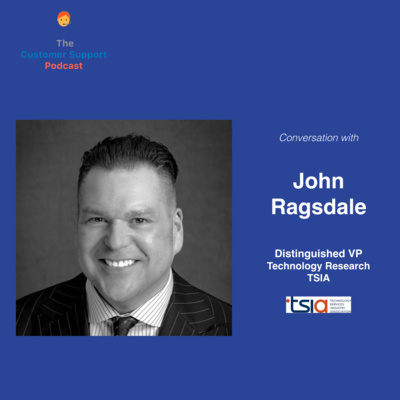
Episode 13: (B2B) John Ragsdale, Distinguished VP, TSIA
This is a special episode as John is a Distinguished Researcher at TSIA -- an organization that works with Support Leaders in B2B Technology world. Listen to it to understand what Support Leaders are thinking, what are they doing well, where are they struggling (where they are going to spend money) etc. Must-listen episode!
Key Insights
- Fun fact: TSIA used to be called SSPA — Services and Support Professional Association
- TSIA maintains a list of Business Challenges — Organizational structure: Swarming vs Tiered Structure, Metrics: What metrics should I be tracking / What’s the average, Self-service / Knowledge-Management, Channel Mix: Introducing digital channels and moving away from phone/email & Customer Experience: How should we track it… how to set compensation structure.
- For SaaS vendors, most of the support questions are around how-do-I-something (vs legacy hardware vendors where most questions were around break/fix)
- Chatbots: 17% of members say they have a chatbot in place but most of those are pilots and not launched. 30% of these customers have built themselves (John doesn't recommend doing it)
- Workforce scheduling/assigning cases automatically is still being done manually/spreadsheets in B2B.
- Only 5% of members have a mobile-app for Support. Making support website HTML-5 is not good enough … most of support websites have rendering challenges on mobile phones/iPads.
- 92% customers start with google search and if support portal content is not indexed, customers won't come to the support site. More than 50% of vendors are google-indexed though. Legacy hardware vendors tend not to do google indexing though
- Support issues are going up 20% YoY… its hard for support organizations to grow in terms of people to match that demand so automation is a must
- Knowledge Management: 41% vendors responded that they could get 30% or more productivity gains if knowledge was being shared better.
- John is bullish about using RPA in Support.
- Customer success is not a department but a culture! Also, using Professional Services team to do Customer Success.
- Next-gen Support: Persistent, Personalized, Intelligent
- Recommendation for CEOs: Don't treat Support as just a cost-center. They have the most visibility and influence with Customers & they can share great information and insight with engineering and product to make products better and control churn. Support also feeds into QA and engg teams.
- Recommended books: Bad Blood/Theranos and Applied Artificial Intelligence: A Handbook for Business Leaders

Episode 12: (B2C) Brenda Guardado, Head of Support, Coffee Meets Bagel
Key Insights
- Tech Tool Stack: Zendesk (Ticketing, Helpdesk, AnswerBot), Sprout Social (Twitter, Facebook), Mode (Data Science)
- Ticket Volume: Few hundred tickets on a daily basis
- Ticket across channels: 80% Email, 10% (Twitter, Facebook, Instagram, Reddit), 10% (Google PlayStore, Apple App store
- Case deflection with Answer Bot is ~5%
- They have Tiered Support — Tier-1/Tier-2 (outsourced), Tier-3 (internal). 8 support employees
- Metrics : First Response Time (FRT), Customer Satisfaction (CSAT), Full resolution time, Customer Request Volume
- They decided to delist from Galaxy Store due to overhead of software maintenance, need for support agents to have a separate testing unit and lack of RoI in terms of users.
- Chat "bots" didn’t work for them in the past but they are considering introducing live chat
- Also, exploring customer communities after seeing good engagement on reddit
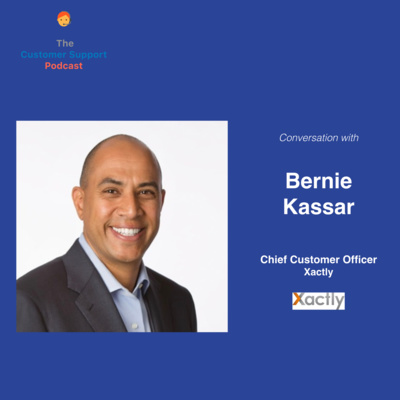
Episode 11: (B2B) Bernie Kassar, Chief Customer Officer, Xactly
Key Insights
- When does the role of Chief Customer Officer makes sense in a company's journey?
- As CCO, following teams fall under Bernie — Customer Success, Renewals, Alliances (Independent Software Vendors or ISVs like Workday etc, System Integrators or SIs like Accenture, Business Development).
- Why customer success and renewals are separate for them?
- Tool Stack: Centered around Salesforce, Khoros/Lithium (Community) Kite (Search), Gainsight (Customer Success), RingCentral (Contact Center), Pendo (NPS)
- Important Metrics — Churn, Customer Sentiment, Support Coverage, Training/Revenue of System Integrators.
- NPS Surveys — Divide their customers in batches of 1/6th and run the survey every 2 months that covers all customers in an year. That way you get best of both worlds -- frequent customer pulse without sending too many surveys to everyone.
- Business Books: 3 Biographies -- Steve Jobs, Shoe Dog: A Memoir by the Creator of Nike, Elon Musk and books by Malcolm Gladwell specially The Tipping Point: How Little Things Can Make a Big Difference
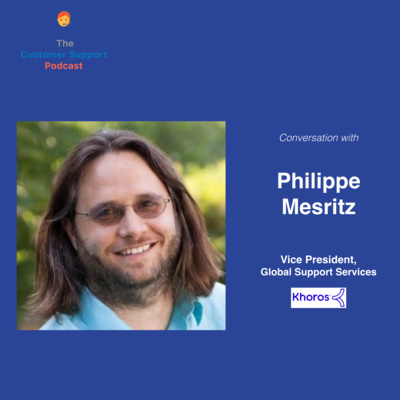
Episode 10: (B2B) Philippe Mesritz, VP Global Support Services, Khoros
Key Insights
- Unlike most B2B companies, Khoros doesn't have tiered support. Philipe says a good way to think about their support is following -- Tier-0 is the customer, Tier-1 is the support community and Tier-2 is their own support.
- Khoros provides support for primarily Fortune 5000 companies and their support team is structured accordingly -- 110 people globally. Philippe has 5 functions in his team -- Program Management (Surveys etc.), Information experience (document, in-app support, community), Support Engg (backend support), Enterprise Account Support / Technical Account Management and Technical support (biggest team..almost 70 people). Customer Success is done by a different team.
- Philippe believes that in charging for support separately from product subscription (as long as the support is something that customers value).
- Their technology stack -- No IVR, Salesforce case management, Community (Khoros), JIRA/confluence (Engg), Squelch and Pendo.
- Incoming ticket bandwidth: < 1% social ,
- How to make communities successful: 1/ Provide a reason for customers to go to community ("whats in it for me?". 2/ Customers need to feel that they “own” part of the community (using gamification to encourage peer responses). 3/ Ubiquitous (insert community in blog posts, marketing newsletters etc.).
- Chatbots can be successful only to the extent that they are option-based or workflow-based.
- How best to organize documentation teams around the concept of Information Experiences (IX)
- Next-gen support will be smooth, low-effort, predictive.

Episode 9: (B2B/B2C) Rick Gianvecchio, VP Customer Support, Okta
Key Insights
- "Nobody wakes up in the morning thinking that they will call Support".
- Why email is not a great channel for support (a consistent message that I hear from all my guests).
- Okta is a unique B2B company in that they are actively looking at social media for understanding and resolving issues reported by customers.
- 70% tickets get closed by Level-1 support, 15% by Level-2 and rest by Level-3 (most sophisticated).
- Best way to make a case go away is to push information upstream (towards customer) so that the case would not need to ne filed. Requires combing and understanding patterns in data. This "personalization of support" is what will be the bedrock for next-gen customer support.
- Related themes around case tagging/categorization and case routing (Rick mentioned that if a customer had a great experience with an agent before, it might make sense to direct the customer to the same agent even if the agent may not be the person to solve the case; at least they will take it to completion).
- Encourage agents to document solutions through Knowledge Creation Program.
- Technology stack optimized around Salesforce.
- Frequency of customer engagements is so high that Support needs to be seen as extension of the product team.
- Favorite book -- Shackleton's Way by Margot Morrell and Stephanie Capparell.
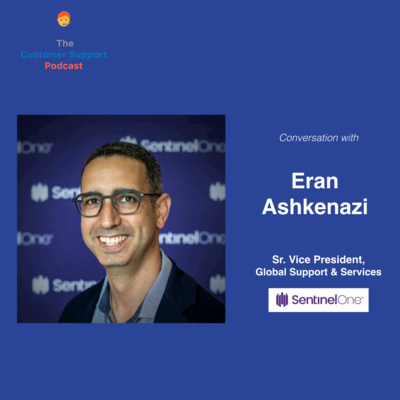
Episode 8: (B2B) Eran Ashkenazi, SVP Global Customer Support, SentinelOne
Key Insights
o SentinelOne has ~2500 customers (globally) which includes both Fortune 100 customers and small businesses. SentinelOne is also part-SaaS, part-hardware. All this puts a unique challenge on customer support — different language support, 24x7 phone service, customers coming through channel (distributors/MSPs) etc.
o Technology stack — standardized on Zendesk. Call center is TalkDesk. Search is Zendesk but could be better. Salesforce is the system of truth (CRM) and there is a desire to standardize around that.
o A good part of our conversation was dedicated to challenges in getting the tools to work with each other specifically Zendesk to Salesforce and how customer success requires yet another bolt-on. Queries coming through channel has unique challenges as well (understanding full customer context, making sure that issue context is transferred from partner to vendor etc.)
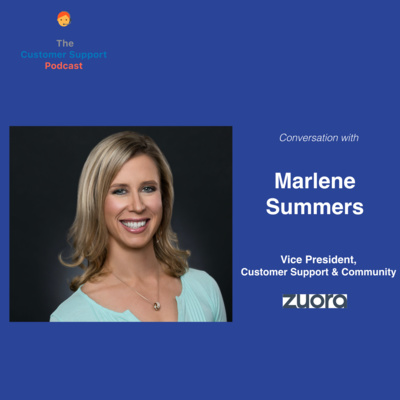
Episode 7: (B2B) Marlene Summers, VP Customer Support & Community, Zuora
Key Insights
o Team follows the operation principle of PADRE - Pipeline, Acquire, Deploy, Run, Expand. Covered here in detail.
o Technology Stack
Ticketing, Voice, Portal - Zendesk
Knowledge Management - Mindtouch
Online community - Lithium
Search - Solvvy, SearchUInify
Agent Training - Skilljar
o Marlene is currently focusing on following initiatives:
- optimizing Agent training and on-boarding
- understanding the persona of the person calling
- auto case routing (speed + accuracy = customer experience)
o Favorite business books:
Subscribed, Tien Tzuo
Nevertheless, She Persisted: True Stories of Women Leaders in Tech, Pratima Rao Gluckman

Episode 6: (B2B) David Rubinstein, VP Customer Success & Strategy, Reps.AI
Key Insights
o David introduced terminology — “Rep-first” and “Rep-experience” i.e., Focus on hiring and creating the best experience for agents in terms of giving them full knowledge about your product (especially the bad stuff).
o Don’t mix commercial aspects (renewal, upsell) into customer “success”. Just let them focus on on-boarding, adoption and value add.
o Tools — Completely on Zendesk stack. For data insights, use Zendesk Insights and Google Data Studio.
o Chatbots — not ready yet for primetime even for B2C.
o Metrics — David said something very interesting here. “I tell my agents that don’t think about the queue, its my problem. You focus on quality and answering right and answering good”. In summary, David measures himself on request-to-wait and his agents on CSAT, and one-touch resolution.
o NPS — hit or a miss because customer is not necessarily rating just the support. David uses NPS, CSAT and monthly interviews with customers to get a pulse of his customer base.

Episode 5: (B2B) Nir Galpaz, VP Technical Services & Support, Blue Jeans Network
Key Insights
o Hardware vs SaaS support — Risk is shifted to the vendor in SaaS world. This is both good and bad. Good because support is now being seen as part of the overall product offering and consequently support organizations now have a stronger voice internally. Bad thing is that if you lose a customer, its on you :)
o Future of Support — Exception Center and not a Contact Center.
o No email support — they are 2x/3x more inefficient in terms of solving the case as compared to web/chat-based cases. Why inefficient? 1/ Emails usually do not contain full context to solve the case. 2/ Email don’t offer real-time communication (like chat)
o Roughly 20% cases come over phone and rest over chat and web.
o First B2B organization (that at least I heard of) that is moving from inbound calls to outbound call i.e., customers request online to be called back at a certain time. Nir brought up that the biggest advantage in this approach is that when they make the call they already know about who the customer is and their entire context which helps them solve problems faster.
o Tool stack — Consolidating around Salesforce (CRM, KnowledgeBase,Search). RingCentral for Contact Center. They also plan to launch chatbots by end of this year.
o Favorite Business Book — The 7 Habits of Highly Effective People / The 7 Habits for Mangers By Stephen R. Covey
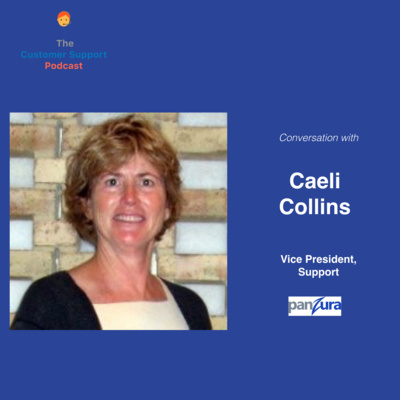
Episode 4: (B2B) Caeli Collins, VP Customer Success & Support Panzura
Key Insights
o First, no relation to our previous guest :)
o Their attrition is super low ~2% (TSIA says average is about 15%). They have built a collaborative culture in support e.g., Level 3 people do not own cases, they just help other folks close theirs.
o Panzura NPS is 82! Average for tech industry is around 21. One of th
o One interesting metric that Caeli does NOT keep track of is time-to-close. She explains why in the podcast. Caeli also keeps track of this unique metric (which I haven’t heard before but it actually makes lot of sense) — number of tickets escalated to engg.
o Support Tools — Salesforce for everything.
o Caeli mentioned that search continues to be broken. Google search appliance (now EoL) was cheap and easy to setup and it worked. Current solutions are opposite.
o They build lot of tools/scripts internally around product health specially data warehouse that stores all the logs pertaining to a given case.
o Favorite business book — In search of Excellence by Tom Peters, and, Grit by Angela Duckworth.
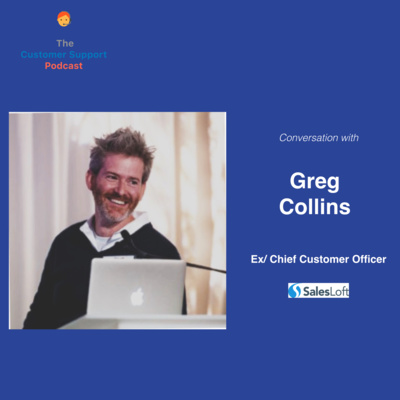
Episode 3: (B2B) Greg Collins, Ex-Chief Customer Officer Salesloft, Ex-VP Support Zendesk
Key Insights
o Greg introduced the concept of "People-first Revenue Generation" i.e., put People above Process and Technology.
o 5 Metrics that Support leaders should keep track of:
CSAT - Customer Satisfaction
FRT - First Reply Time
Requestor wait time
Agent Turnover
Agent satisfaction (Not EPS — Employee Promoter Score).
o Option Bots vs Answer Bots
o Support Challenge -- Companies continue to look at support as a cog which doesn't make sense in a recurring revenue/empowered consumer market.
o Focus on empowering “both” customers and agents vs ticket deflection — different intent and will likely have different results.
o Tiered support will tend to create culture of competition. You need to watch out for that. Instead create culture of collaboration — “serve the person in front of you” i.e., Level 3 coaches Level 2 and so on.
o Customer Experience vs Support Experience
o Favorite Business Book — “The Service Culture Handbook” by Jeff Toister.
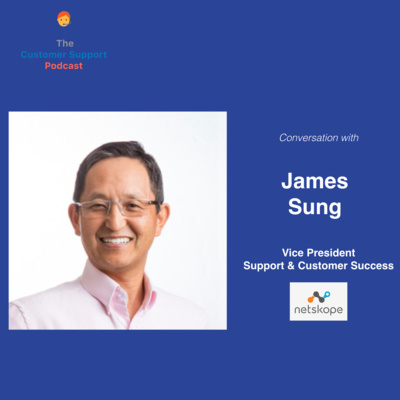
Episode 2: (B2B) James Sung, VP Global Support, Netskope
Key Insights
o Hiring tips from James that I found to be really unique:
1. Good balance between senior/junior engineers (preferred ratio 2:1). Junior engineers usually turn out better than experienced folks.2
2. Don’t just look for EE/CS majors. James has successfully hired even bio/physics/maths majors who are also interested in technology
3. Focus on hiring folks from outside the area (such folks will invest heavily in building a culture of assimilation)
o One thing that got my attention is that their attrition is 3%. TSIA says attrition in support is usually around 15% . James shared that they have taken following steps (specifically in their India support team) to control attrition: 1/ Invest in growing support engineers technically 2/ Hiring strong managers 3/ Offer slightly better than market rate.
o Split Customer Success team based on Customer ACV and their ability/interest in being advocates (this seemed a unique segmentation choice). Top bracket customers enjoy 1:10 or 1:20 (CSM/Customer) ratio. For other brackets, ratio is higher. Earlier they started with 1:50 ratio for everyone and that didn't scale.
o Tool stack: Zendesk (CRM/Knowledge Management), Ring Central (Contact Center)
o James says that NPS is the most important customer metric you can measure
o Favorite business book for James: Delivering Happiness by Tony Hsieh

Episode 1: (B2B) Parag Kulkarni, VP SaaS Engineering, Nutanix
Key Insights:
o Nutanix NPS is ~90. For B2B Technology companies, average hovers around 30. Clearly, Nutanix is doing something unique.
o The team that provides technology tools for Support sits within Engineering rather than in IT/Support. I thought this was super clever -- that way head count of the team will come from Engg budget rather than IT budget (Engg budget > IT budget). Also, that way support tools team is sitting closely with engineering allowing them to better align with the product.
o They have built on top of existing support tools (e.g, Salesforce ServiceCloud) to provide unique experiences for their customers e.g., with more than 50% of their machines sending data back to them, they can generate "cross-customer" insights to do proactive support.
o Parag's favorite book: Measure What Matters, John Doerr,